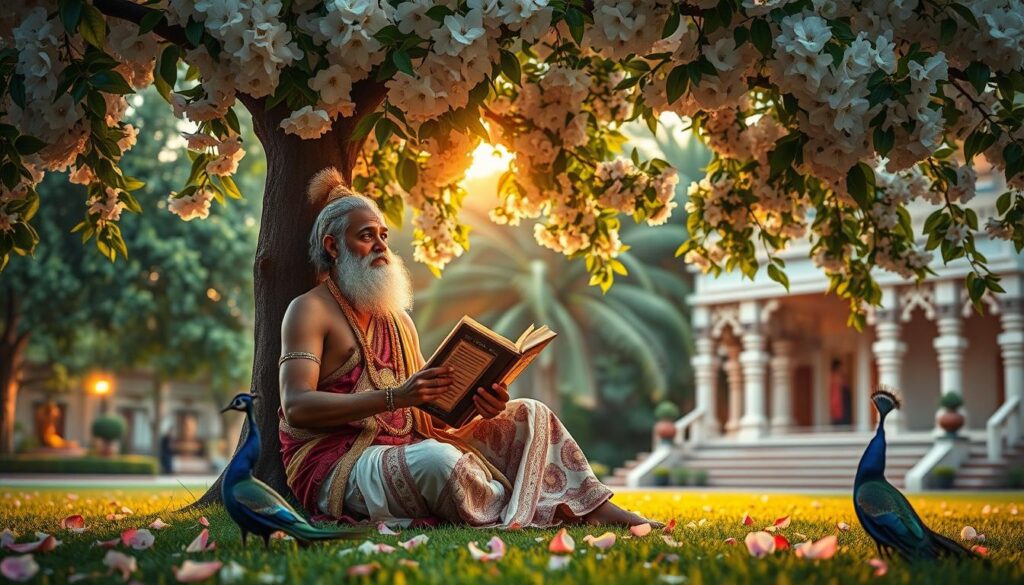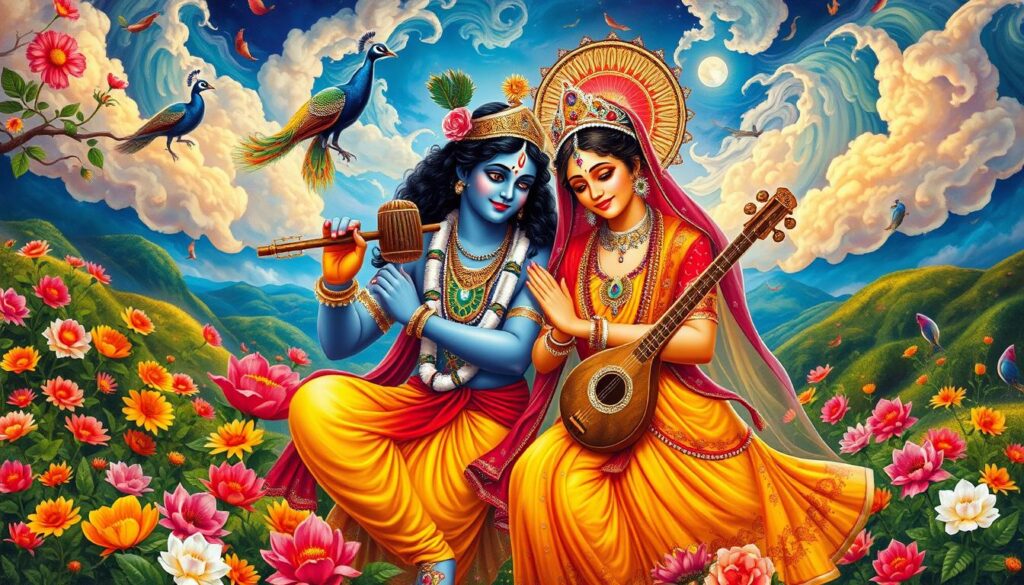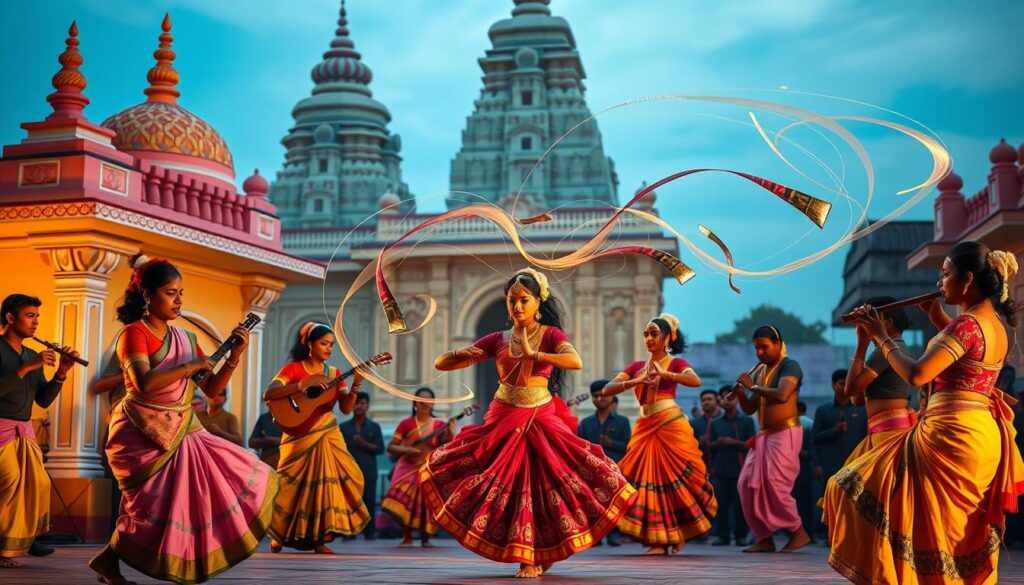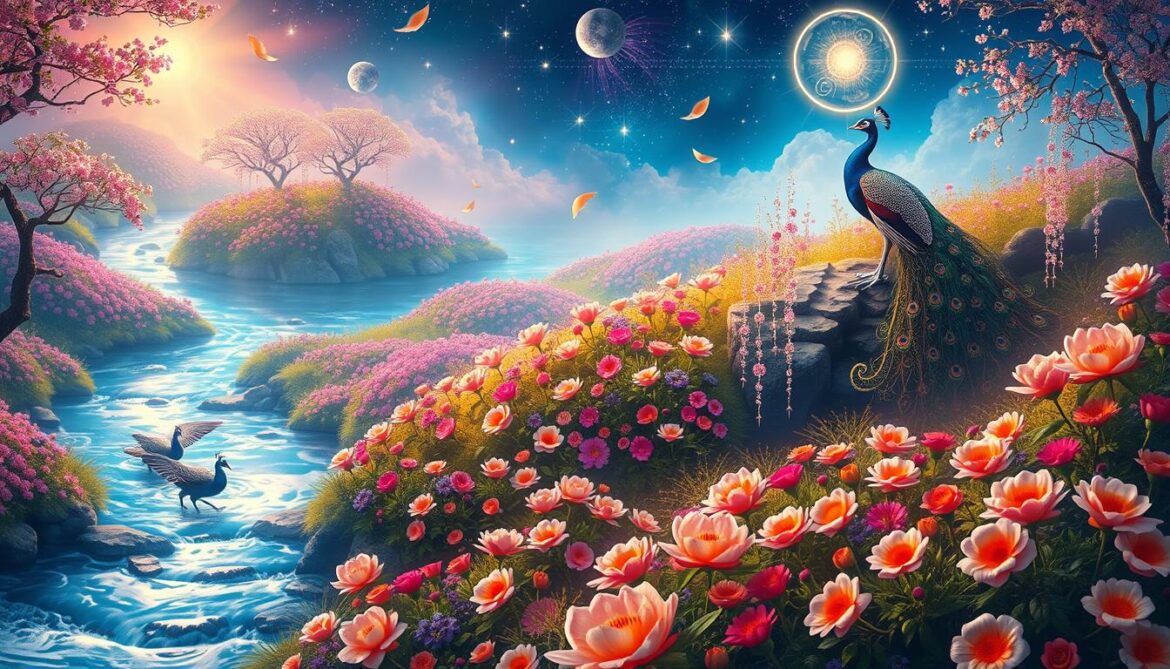In a world filled with daily worries, Gita Govinda by Jayadeva offers comfort. This beautiful sanskrit literature comes from 12th-century India. It tells the love story of Krishna and Radha.
Their love’s beauty touches anyone who has loved. It invites us on a spiritual journey. Through hindu poetry and devotional songs, it shows the depth of human feelings.
Introduction to Gita Govinda
The Gita Govinda, or “The Song of Krishna,” is a key piece of Sanskrit literature. It explores the deep bond between Krishna and Radha and the gopis of Vrindavan. The text uses beautiful verses to show the soul’s search for the divine, revealing the deep sides of love and devotion.
Jayadeva wrote this in the 12th century. It has 12 chapters with 24 musical verses. Each chapter talks about the love between Radha and Krishna. It shows Radha’s complex role as Krishna’s beloved, using the theme of Shringaara Rasa.
The Gita Govinda is not just beautiful but also a spiritual guide. It teaches the value of devotion and the need to understand its deeper meanings. Reading it requires a deep understanding of spiritual feelings. Jayadeva’s style has inspired many, enriching Krishna devotion in Indian literature.
The Poet: Jayadeva and His Era

Jayadeva was a key figure in 12th century Indian literature. He is famous for the Gita Govinda, a work loved for over eight centuries. This text shows the deep bond between Radha and Lord Krishna in a unique way.
He lived in Eastern India and showed his love for Krishna through his poems. His time was filled with the Vaishnavism movement, blending spirituality and art. The Gita Govinda, written around 1190, enriched devotion and showed the beauty of love.
For over 700 years, the Gita Govinda has been a daily part of the Jagannatha temple in Puri. It’s still loved today. Three states—Bihar, Odisha, and West Bengal—claim Jayadeva as their own. This text is seen as a classic, like Da Vinci’s Mona Lisa and Shakespeare’s plays.
Jayadeva was more than a poet; he was a cultural icon. His life, including his marriage to Padmavati, a temple dancer, influenced his work. The tradition of singing the Gita Govinda in Odissi music at the Jagannatha temple shows its lasting impact.
Gita Govinda by Jayadeva: An Overview

The Gita Govinda by Jayadeva is a masterpiece of love, emotion, and spirituality. It dives into the deep bond between Radha and Krishna. It explores desire and devotion through their story.
The text is structured into chapters and prabandhas. This makes the story come alive with beautiful lyrics.
Content Structure: Chapters and Prabandhas
The Gita Govinda has twelve chapters. It includes twenty-four songs and seventy-two slokas. Each chapter is split into prabandhas or sections.
These sections are filled with ashtapadis. They express many emotions and relationships. Jayadeva’s skill in mixing poetry with spiritual lessons is clear.
His life as a wandering Sadhu adds a special touch to the verses. They are known for their beauty and deep meaning.
The Ashta Nayika: Eight Moods of the Heroine
The Gita Govinda introduces the ashta nayika concept. It shows Radha’s eight different moods. These moods cover the full range of emotions in love and longing.
Jayadeva explores these states deeply. He shows how human relationships are connected to the divine. This makes the Gita Govinda a key work in Sanskrit literature.
Thematic Elements of Gita Govinda

The Gita Govinda is a deep dive into love, blending divine love with human feelings. Jayadeva wrote it in the late twelfth century. It shows the bond between Krishna and Radha, full of longing and connection.
This text explores the complexities of their love. It guides us on a spiritual journey towards union.
Divine Love and Human Emotion
The Gita Govinda dives into the deep nature of divine love. It uses Krishna and Radha’s story to show joy, sorrow, and yearning. Their love story is not just romantic.
Radha’s emotional changes show the many sides of love. This poetry lets us see our own spiritual journey in their love.
Symbolism of Krishna and Radha
Krishna and Radha symbolize our search for divine connection. Jayadeva makes Krishna relatable, unlike traditional views. This makes divine love more accessible.
The text shows the pain of separation and the joy of reunion. It highlights love’s power in our spiritual quest.
| Thematic Elements | Description |
|---|---|
| Divine Love | The portrayal of love that connects the divine with the mortal, exploring its transcendent qualities. |
| Human Emotion | Captures the spectrum of feelings experienced by Radha, reflecting on joy, pain, and longing. |
| Symbolism | Depicts Krishna as relatable, moving away from traditional divine representations, emphasizing the personal nature of love. |
| Spiritual Connection | Underscores the idea that love serves as a bridge to achieving spiritual fulfillment and unity with God. |
Sanskrit Literature: Importance of Gita Govinda
The Gita Govinda was written by Jayadeva in the 12th century. It’s a key part of Sanskrit literature. It has complex poetry and deep meaning, making it a vital piece of Indian classical literature.
The text has 12 chapters with 24 sections. Each section has couplets called ashtapadis. This structure is unique and beautiful.
The Gita Govinda’s beauty has won many hearts. It has also shaped many literary movements in India. Musicians in Kerala use its ashtapadis in a tradition called sopana sangeetham.
Notable translators like Edwin Arnold and Barbara Stoler Miller have made it more accessible. Their work has brought the Gita Govinda to more people.
The Gita Govinda is also important in performance arts. It uses specific ragas and talas in Odissi music. Scholars like Kaviraja Narayana Dasa and Rana Kumbha have written about it, showing its wide influence.
Over time, the Gita Govinda has spread across India. It talks about divine love and the bond between Radha and Krishna. Its themes have inspired many artists, including those who create miniature paintings seen in museums like the National Museum in New Delhi.
Today, the Gita Govinda is sung every night at the Jagannatha temple in Puri. It shows its lasting importance in devotional practices. The Gita Govinda is a true treasure of Sanskrit literature and a key part of India’s cultural heritage.
| Features of Gita Govinda | Details |
|---|---|
| Composed by | Jayadeva |
| Chapters | 12 |
| Sections | 24 ashtapadis |
| Musical Adaptation | Sopana sangeetham |
| Notable Commentaries | Kaviraja Narayana Dasa, Rana Kumbha |
| Translations | Available in most Indian languages and various European languages |
| Performance | Sung at Jagannatha Temple in Puri |
Musical Influence and Traditions

The Gita Govinda by Jayadeva has deeply influenced Indian music, especially odissi music. This dance form uses Gita Govinda verses with different melodies and rhythms. It creates a rich sound experience.
Each song, or ashtapadi, matches specific melodies and rhythms. This brings out the deep feelings of love and longing in the text.
Odissi Music and Gita Govinda
Odissi music shows Jayadeva’s impact, with many Gita Govinda songs performed in temples and cultural events. The mix of music and dance in odissi enhances the beauty of Gita Govinda’s lyrics.
Various melodies like Malav, Gurjari, and Vasanta are used, along with rhythms like Rupaka and Nihsara. The timing of these melodies, especially Vasant raga, adds spiritual depth to the performances.
Famous Compositions Inspired by the Work
Many compositions inspired by Gita Govinda have stood the test of time. By the 14th century, they became widely known across India. Their themes have been used in poetry and dramas, showing the text’s lasting impact.
Each song has its musical setting, with Jayadeva’s use of local flowers like Nalini and Kamala. This shows the deep connection between culture and devotion in these performances.
| Raga | Associated Talas | Characteristics |
|---|---|---|
| Malav | Rupaka | Soft and romantic, often used for expressing themes of love |
| Gurjari | Nihsara | Invokes a sense of devotion and longing |
| Vasanta | Jati | Celebratory and vibrant, symbolizing the arrival of spring |
The Gita Govinda’s impact goes beyond literature. It has created a lasting cultural heritage in odissi music and other artistic forms in India.
Translations and Interpretations
The Gita Govinda has reached readers worldwide, spreading its influence far from its Sanskrit roots. Many translations have brought Jayadeva’s beautiful words to life. This has made its themes of divine love and devotion known globally.
Notable Translations Around the World
Many scholars have worked on translating this important work. Notable translators include:
- Sir William Jones – His translation highlighted the text’s lyrical beauty.
- Barbara Stoler Miller – She focused on the poetry and cultural depth of the verses.
These translations show how Jayadeva’s poetry can be understood and loved by many.
Impact on Modern Literature and Poetry
The Gita Govinda’s impact is seen in modern literature and poetry. Its themes of love and divine connection inspire today’s writers. Literary movements worldwide find inspiration in Jayadeva’s emotional depth.
This shows how ancient texts can influence modern creativity. They blend old values with today’s feelings.
Legacy and Cultural Significance
Gita Govinda’s legacy lives on in many art forms. It has made a big impact on both contemporary art and classical dance in India. Artists and dancers use its imagery, showing how old stories connect to today’s art.
Gita Govinda in Contemporary Art and Dance
Many modern art pieces reflect the feelings and stories of Gita Govinda. They mix old themes with new styles. In dances like Odissi, Radha and Krishna’s love is shown in lively performances.
This keeps the text’s messages alive in today’s art world.
Preservation in Museums and Collections
Gita Govinda is kept in museums worldwide, showing its lasting appeal and importance. Places like the Odisha State Museum have many illustrated manuscripts. These show the art and skill behind Jayadeva’s work.
Special shows on Gita Govinda help people see its place in Indian history. They make us think about its ongoing importance.
Where to Find Gita Govinda Resources
For those eager to dive into the Gita Govinda, many resources are out there. You can find the Gita Govinda PDF online. It comes with study guides and commentaries that make it even more interesting.
These tools help scholars, students, and fans understand the poem’s deep themes and cultural background. They make exploring the Gita Govinda a rewarding experience.
Physical libraries and bookstores also have a lot to offer. They have translations and essays about the Gita Govinda. Famous translators like Edwin Arnold and Monica Varma share their views, giving readers different ways to see this cultural gem.
Having these resources helps us get to know Jayadeva’s work better. It lets us appreciate its beauty and meaning more fully.
Many schools also teach the Gita Govinda. This makes it easier for students to learn about this beautiful poem. Whether in class or on their own, the Gita Govinda keeps touching hearts. Its lasting impact grows thanks to the resources we have today.

